Magazzù M16: here’s how the new flagship sails in difficult conditions
Magazzù has always been the undisputed icon of top-of-the-range maxi-ribs – fascinating inflatable boats that make beauty and reliability at sea their strong points. These characteristics merited a closer look at the world premiere of the shipyard’s new flagship: the Magazzù M16.
Magazzù M16: the sea trial
“The conditions that await us are prohibitive for most boats”.
That’s exactly what I think as I climb aboard the new Magazzù M16. We’re in Genoa’s commercial port, and the 17-meter maxi-rib has just been unloaded from the ship that brought it here, directly from Palermo, the Sicilian yard’s historic headquarters.
We have 100 miles of sea to reach Cannes, an itinerary that will take us through increasingly demanding weather and sea conditions, with a final stretch that, at least on paper, is decidedly challenging.
The naval engineering of this maxi-rib has been studied in depth by Alfredo and Renato Magazzù, two professionals who certainly need no introduction. Valuable experience which, thanks to this project, has reached its apogee since, for the first time in the site’s history, a hull has been specially designed for IPS propulsion and, for this reason, has no steps.
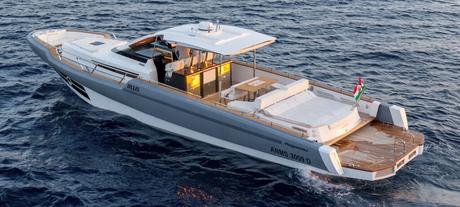
On board with me is Claudio Magazzù, designer and creator of the new M16. I’ve sailed with him a lot, he’s an experienced skipper who really enjoys sailing his creations, and believe me, that’s not such a common characteristic…
As we leave the harbour, we immediately find a long swell which, as Murphy’s Law dictates, obviously comes from the bow. I take the helm and push the joysticks forward, while the Magazzù M16, powered by its two Volvo Penta D8-IPS-800s (each with 600 hp), glides in easily, with hardly any change in trim.
I’m impressed by this feature: boats equipped with IPS, because of their propeller drives, normally tend to plunge steeply at the stern, an annoying behaviour that this maxi-rib seems to be unaffected by.
I’m sailing at around 30 knots, the bow of the Magazzù M16 splits the long swell without hesitation, while on board sailing comfort is excellent, well above average. A glance at the dashboard and I discover that we consume just 6.2 liters of fuel per mile, which, for a boat of almost 17 meters and 20 tons (with full tanks), isn’t bad at all!
Given that the sea still allows us to do so, I push the levers hard, the acceleration is powerful and the GPS figures rise rapidly. The Magazzù M16 easily reaches a little over 38 knots, then I play with the trim and, surprise, we exceed 40 knots! It’s the first time this has happened to me (and I’m trying out a lot of boats) with a boat fitted with IPS propulsion.
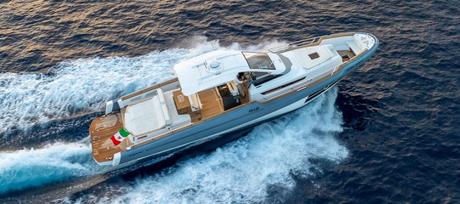
I slow down and position myself at around 30 knots, then turn quickly to the left, the maxi-rib tilts and enters a sharp bend, sailing as if on rails.
I counter-turn to the right and, once again, with an agility unthinkable for a boat of this size, I find myself crushed by centripetal force against the new walls.
This new Magazzù M16 is a lively, responsive boat. A maxi-rib that definitely knows how to deliver adrenalin when you want it.
Continuing on our way, as planned, when we’re off Loano, the wind picks up and the swell starts to turn to gran largue and get bigger. It gradually increases and, near Imperia, reaches a height of over two metres.
However, the Magazzù M16 continues to sail easily at around 28/30 knots. With an almost supernatural comfort, it faces and overcomes the waves, smoothly and without hesitation. Of course, you have to steer in these conditions, but for the moment we don’t feel the need to slow down.
The last 20 miles are the most difficult. The sky is getting darker and the wind is increasing again. The waves are really high now, well over 3 metres. The crests are breaking and the wind is bringing white foam on board.
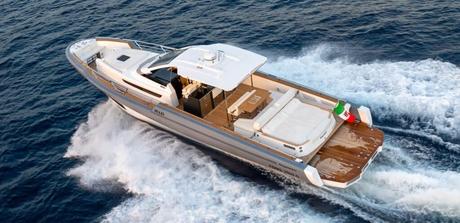
In these conditions, I necessarily have to change my piloting style, so I reduce speed and start using the joysticks. It’s necessary to slow down as you descend into the trough, then accelerate as you climb back up those mountains of water. The rudder is also fundamental in this situation, as waves coming in from the open sea tend to move the stern, so you need to anticipate by countering, then get back on course.
On board the Magazzù M16, however, calm reigns. Sailing at around 23/24 knots average speed, with the aforementioned precautions, we approach the situation in complete safety, once again with comfort well above the norm. This boat never bumps into the waves.
So we pass Cap d’Antibes, enter island cover and the sea calms down, gradually the swell diminishes and turns into a long swell.
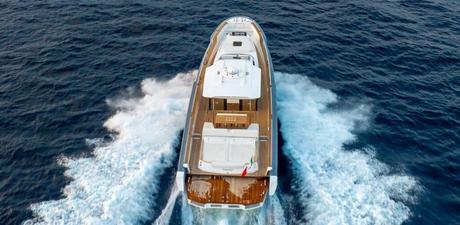
A blue motorboat about 12 metres long joins us, obviously eager to race. I look at Claudio, he smiles and I push the levers again. The Magazzù M16 leaps forward, reaching 40 knots in no time at all, unperturbed by the long swell which it crosses without a hitch.
We sail along, side by side with the motorboat, for a handful of seconds, then a wave higher than the others arrives and the motorboat runs aground and slows down abruptly, raising a column of water six or seven metres high.
We, on the other hand, continue our course, smiling, as our boat glides free and serene over the water, until we reach the limit of the low-speed zone near Cannes, where we must necessarily slow down.
As we sail slowly, I think back to my initial thought: “These are prohibitive conditions for most boats.” and I can’t help but notice that, obviously, I was absolutely right…
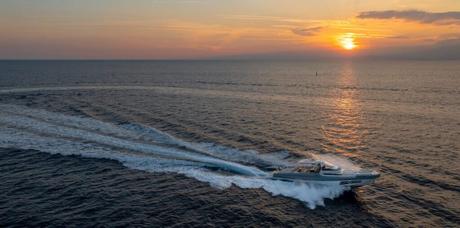
Test data
RPM SPEED L/H L/NM
600 5,8 5,8 1,0
1.000 8,5 18,7 2,2
1.250 9,6 31,7 3,3
1.500 11,0 58,3 5,3
1.750 13,4 81,7 6,1
2.000 19,0 110,2 5,8
2.250 24,2 145,2 6,0
2.500 28,2 172,0 6,1
2.610 30,3 187,9 6,2
2.750 32,2 202,9 6,3
3.000 36,9 239,9 6,5
3.250 40,3 266,0 6,6
The Magazzù M16 in detail
Let’s start by saying that no two Magazzù are the same. The shipyard built in semi-customThis means that each boat can be customized to suit the owner’s needs.
The model we tested, which reflects the features chosen by its enlightened owner, in addition to the choice of IPS motorization, wanted interiors that meet his goûts. When we go down to the lower deck, we find a dinette which, equipped with an L-shaped sofa and table on the right, and an opposite sofa on the left, can comfortably accommodate 5 or 6 guests.
From here, a corridor leads to two large bathrooms with separate showers and seating. Continuing forward, we discover the main cabin, with its central bed, and a double bed. king sizeis literally dotted with cupboards and closets offering ample storage capacity.
Moving aft, we discover the Magazzù M16’s second cabin which, although located under the cockpit, nonetheless manages to offer more than sufficient headroom for sleeping in the utmost comfort. Here again, the bed is of ample dimensions.

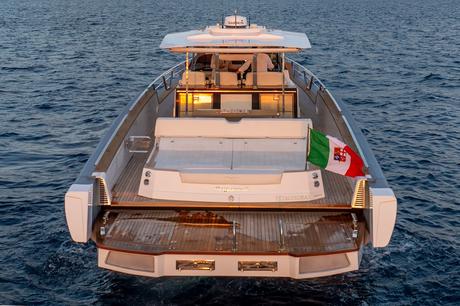
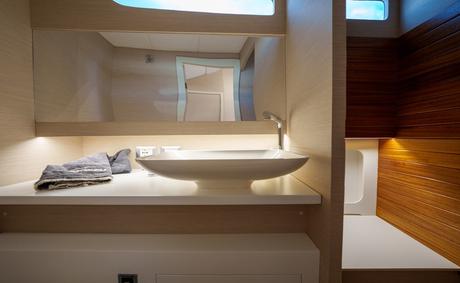
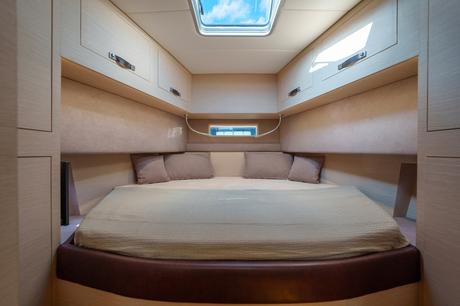
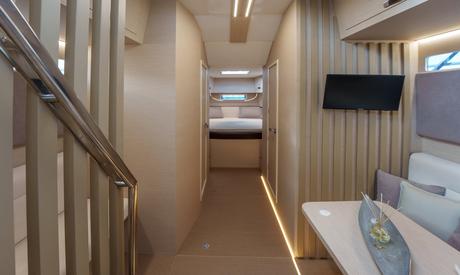
The deck layout features a huge aft platform that conceals a pair of very useful lockers. Continuing forward, we find a central sundeck that helps create the aft settee for the outside dinette.
This area is really spacious and functional, with two opposing sofas, one U-shaped and one traditional, allowing 8 people to dine very comfortably. The front sofa, thanks to an adjustable backrest, transforms into a second sofa facing the sea, both useful and comfortable.
Finally, five refrigerators adorn the console that houses the galley, which can optionally accommodate sinks, hobs and grills. The entire area is shaded by the Hard-Top and the electrically extendable bimini.
Beneath the huge Hard-Top is the helm cockpit, with seating for four facing the sea. The console is positioned to the right, offering ample space for two large screens and all the on-board electronic instrumentation.
At the extreme bow, we find a second large sundeck which, thanks to the opposite sofa, forms a second and precious convivial space.
Technical specifications
Overall length
16,70 m
Bau Maximal
4,80 m
Freshwater capacity
400 L
Fuel capacity
2 x 1.000 L
Maximum power
1,800 HP
IPS version
2 x D8 IPS 800 with 600 HP
Outboard version
3 x 600 hp
CE category
B – 20 Passengers
